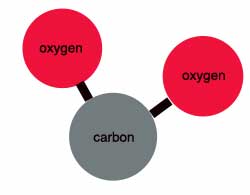When ginger ale is poured into a glass, it foams. The same thing happens with all kinds of soda drinks. Ice-cream sodas foam, too. The foam on all these drinks is made of tiny bubbles of carbon dioxide. The carbon dioxide helps to make the drinks refreshing.
CO2 is the chemist's way of writing carbon dioxide. The C stands for carbon, and the O for oxygen. The chemist's way of writing the name shows that in carbon dioxide there are two atoms of oxygen for every atom of carbon.
Carbon dioxide is produced in many ways. Almost all fires give off carbon dioxide. It can be made by mixing baking soda and vinegar. It can be made by adding water to baking powder. Yeast produces bubbles of carbon dioxide when it is put in bread dough. We ourselves breadle out carbon dioxide all the time. It comes from the slow "burning" of the food we eat. All other animals breathe out carbon dioxide just as we do. No wonder there is always some carbon dioxide in the air!
Carbon dioxide is a very important substance. It does far more than make sodas taste good and make bread and cake puff up. Many fire extinguishers work by producing carbon dioxide. More important, green plants use carbon dioxide in making sugar. Without carbon dioxide for making sugar, they could not live. Neither could we, for we can trace all our food except salt and water back to the sugar that is manufactured by green plants.
Carbon dioxide is a gas. But it can be frozen so that it is as solid as a rock. We call frozen carbon dioxide "dry ice." Dry ice is so cold that it is dangerous to handle. It is useful in packing ice cream and other frozen foods for shipping. Unlike real ice, it does not make anything wet. Instead of melting, dry ice changes back to a gas (sublimation).
